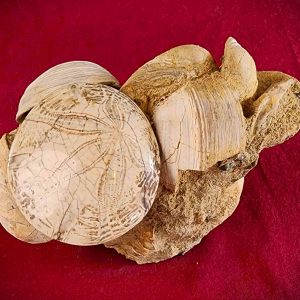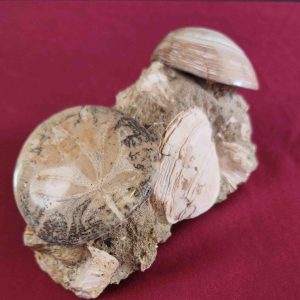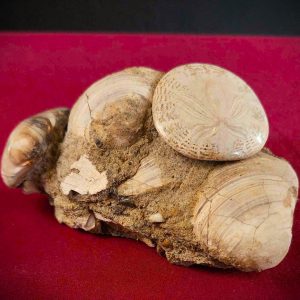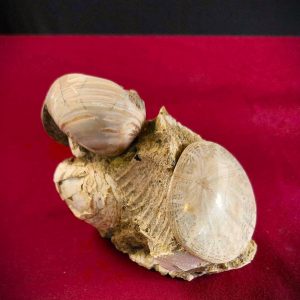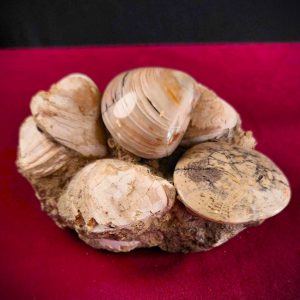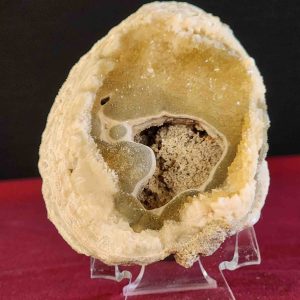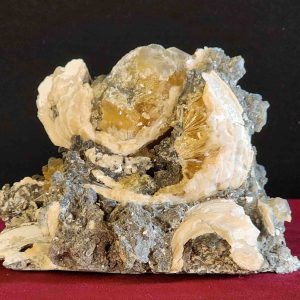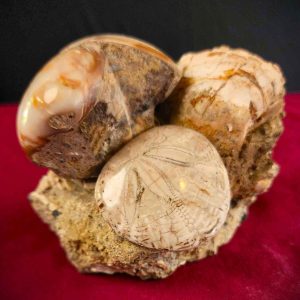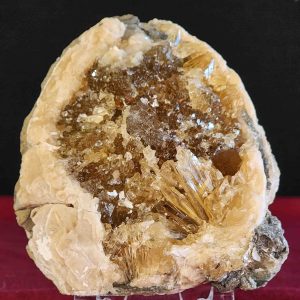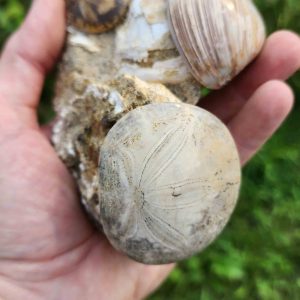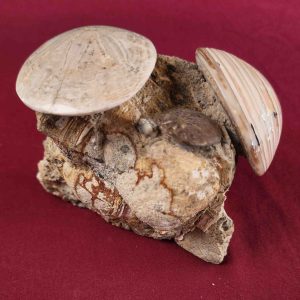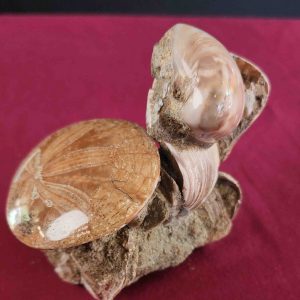Fossils
-
Fossil Sand Dollar and Clam (KH1)
These well-preserved clams and sand dollars lived in a shallow sea that covered the San Joaquin Valley for millions of years. During storms the animals became buried in sediments which preserved the shells. Under heat and pressure, the shells altered into calcite, yet preserved their fine detail. Later, due to movement of the nearby San Andreas fault, the whole area was uplifted, becoming the Kettleman Hills. The Hills became famous for its oil in the 1920s. But the oil has since played out and the land is returning to its former native environment. We’ve polished the primary shells to show their beauty and detail. Iron and petroleum color the shells. We have spent years mapping the Hills and are the only people who know where to find these unique fossils.
NOTE: One superb large sand dollar and several clams. An attractive and informative display card accompanies the specimen.
SIZE: 6″x 3″x 4″
* Shipping includes packaging, insurance, and ground transport in the continental US. Inquire about shipping outside US.
$84.00 -
Fossil Sand Dollar and Clam (KH3)
These well-preserved clams and sand dollars lived in a shallow sea that covered the San Joaquin Valley for millions of years. During storms the animals became buried in sediments which preserved the shells. Under heat and pressure, the shells altered into calcite, yet preserved their fine detail. Later, due to movement of the nearby San Andreas fault, the whole area was uplifted, becoming the Kettleman Hills. The Hills became famous for its oil in the 1920s. But the oil has since played out and the land is returning to its former native environment. We’ve polished the primary shells to show their beauty and detail. Iron and petroleum color the shells. We have spent years mapping the Hills and are the only people who know where to find these unique fossils.
NOTE: One large polished sand dollar with a great polished clam.An attractive and informative display card accompanies the specimen.
SIZE: 4″x 3″x 3″
* Shipping includes packaging, insurance, and ground transport in the continental US. Inquire about shipping outside US.
$84.00 -
Fossil Sand Dollar and Clam (KH5)
These well-preserved clams and sand dollars lived in a shallow sea that covered the San Joaquin Valley for millions of years. During storms the animals became buried in sediments which preserved the shells. Under heat and pressure, the shells altered into calcite, yet preserved their fine detail. Later, due to movement of the nearby San Andreas fault, the whole area was uplifted, becoming the Kettleman Hills. The Hills became famous for its oil in the 1920s. But the oil has since played out and the land is returning to its former native environment. We’ve polished the primary shells to show their beauty and detail. Iron and petroleum color the shells. We have spent years mapping the Hills and are the only people who know where to find these unique fossils.
NOTE: One large polished sand dollar with a great polished clam and some unpolished clams as well. An attractive and informative display card accompanies the specimen.
SIZE: 5″x 2″x 3″
* Shipping includes packaging, insurance, and ground transport in the continental US. Inquire about shipping outside US.
$84.00 -
Fossil Sand Dollar and Clam (KH8)
These well-preserved clams and sand dollars lived in a shallow sea that covered the San Joaquin Valley for millions of years. During storms the animals became buried in sediments which preserved the shells. Under heat and pressure, the shells altered into calcite, yet preserved their fine detail. Later, due to movement of the nearby San Andreas fault, the whole area was uplifted, becoming the Kettleman Hills. The Hills became famous for its oil in the 1920s. But the oil has since played out and the land is returning to its former native environment. We’ve polished the primary shells to show their beauty and detail. Iron and petroleum color the shells. We have spent years mapping the Hills and are the only people who know where to find these unique fossils.
NOTE: One large polished sand dollar with a great polished clam.An attractive and informative display card accompanies the specimen.
SIZE: 4″x 2″x 3″
* Shipping includes packaging, insurance, and ground transport in the continental US. Inquire about shipping outside US.
$88.00 -
Fossil Sand Dollar and Clam (KH7)
These well-preserved clams and sand dollars lived in a shallow sea that covered the San Joaquin Valley for millions of years. During storms the animals became buried in sediments which preserved the shells. Under heat and pressure, the shells altered into calcite, yet preserved their fine detail. Later, due to movement of the nearby San Andreas fault, the whole area was uplifted, becoming the Kettleman Hills. The Hills became famous for its oil in the 1920s. But the oil has since played out and the land is returning to its former native environment. We’ve polished the primary shells to show their beauty and detail. Iron and petroleum color the shells. We have spent years mapping the Hills and are the only people who know where to find these unique fossils.
NOTE: Excellent group of clams with one nice large polished sand dollar. An attractive and informative display card accompanies the specimen.
SIZE: 5″x 3″x 3″
* Shipping includes packaging, insurance, and ground transport in the continental US. Inquire about shipping outside US.
$96.00 -
Crystalized Clam (OK2)
Crystalized fossil clams like this are exceptionally rare. These clams lived in a shallow sea that covered most of Florida 2 million years ago. A sudden storm event buried the clams, trapping cavities inside. When the shells began to dissolve, it provided the material necessary to grow calcite crystals in the open spaces. These unusual fossils are known from only one site, an old quarry near Lake Okeechobee. The quarry played out and flooded in 2007. We excavated this in 2023. An attractive and informative display card accompanies the specimen.
Notes specific to this specimen: Druzy honey calcite crystals make this a very unique specimen.
SIZE: 4″x 3″x 2″
NAME: Mercenaria permagna
AGE: Pleistocene 2 million years
UNIT: Nashua Formation
SITE: Okeechobee County, FloridaDocumentation: This authentic fossil specimen comes with a Certificate of Authenticity and Origin.
$275.00Crystalized Clam (OK2)
$275.00 -
Crystalized Clam (OK5)
Crystalized fossil clams like this are exceptionally rare. These clams lived in a shallow sea that covered most of Florida 2 million years ago. A sudden storm event buried the clams, trapping cavities inside. When the shells began to dissolve, it provided the material necessary to grow calcite crystals in the open spaces. These unusual fossils are known from only one site, an old quarry near Lake Okeechobee. The quarry played out and flooded in 2007. We excavated this in 2023. An attractive and informative display card accompanies the specimen.
Notes specific to this specimen: Great honey calcite crystals replacing multiple clam shells trapped in matrix. Some excellent radial calcite crystals here as well. This piece has a sawn flat bottom so it stands up nicely on its own
SIZE: 7″x 5″x 5″
NAME: Mercenaria permagna
AGE: Pleistocene 2 million years
UNIT: Nashua Formation
SITE: Okeechobee County, FloridaDocumentation: This authentic fossil specimen comes with a Certificate of Authenticity and Origin.
$380.00Crystalized Clam (OK5)
$380.00 -
Fossil Sand Dollar and Clam (KH9)
These well-preserved clams and sand dollars lived in a shallow sea that covered the San Joaquin Valley for millions of years. During storms the animals became buried in sediments which preserved the shells. Under heat and pressure, the shells altered into calcite, yet preserved their fine detail. Later, due to movement of the nearby San Andreas fault, the whole area was uplifted, becoming the Kettleman Hills. The Hills became famous for its oil in the 1920s. But the oil has since played out and the land is returning to its former native environment. We’ve polished the primary shells to show their beauty and detail. Iron and petroleum color the shells. We have spent years mapping the Hills and are the only people who know where to find these unique fossils.
Notes specific to this specimen: One large polished sand dollar with two great polished clams. Matrix piece that has a flat bottom so it stands nicely.
SIZE: 4″x 2″x 3″
NAME: Psuedocardium & Dendraster
AGE: Pliocene 4 million years
UNIT: Etchegoin Formation
SITE: Kettleman Hills, CaliforniaDocuments: This authentic fossil specimen comes with a Certificate of Authenticity and Origin. In addition, an attractive and informative display card accompanies the specimen.
$395.00 -
Crystalized Clam (OK1)
Crystalized fossil clams like this are exceptionally rare. These clams lived in a shallow sea that covered most of Florida 2 million years ago. A sudden storm event buried the clams, trapping cavities inside. When the shells began to dissolve, it provided the material necessary to grow calcite crystals in the open spaces. These unusual fossils are known from only one site, an old quarry near Lake Okeechobee. The quarry played out and flooded in 2007. We excavated this in 2023. An attractive and informative display card accompanies the specimen.
Notes specific to this specimen: Fantastic radial calcite crystals admist a solid honey calcite matrix. This is a singularly unique find.
SIZE: 5″x 3″x 2″
NAME: Mercenaria permagna
AGE: Pleistocene 2 million years
UNIT: Nashua Formation
SITE: Okeechobee County, FloridaDocumentation: This authentic fossil specimen comes with a Certificate of Authenticity and Origin.
$420.00Crystalized Clam (OK1)
$420.00 -
Fossil Sand Dollar and Clam (KH2)
These well-preserved clams and sand dollars lived in a shallow sea that covered the San Joaquin Valley for millions of years. During storms the animals became buried in sediments which preserved the shells. Under heat and pressure, the shells altered into calcite, yet preserved their fine detail. Later, due to movement of the nearby San Andreas fault, the whole area was uplifted, becoming the Kettleman Hills. The Hills became famous for its oil in the 1920s. But the oil has since played out and the land is returning to its former native environment. We’ve polished the primary shells to show their beauty and detail. Iron and petroleum color the shells. We have spent years mapping the Hills and are the only people who know where to find these unique fossils.
Notes specific to this specimen: Matrix piece that has a flat bottom so it stands nicely. This specimen has one large and one infant sand dollar with a nice polished clam that has great colors.
SIZE: 5″x 3″x 3″
NAME: Psuedocardium & Dendraster
AGE: Pliocene Epoch – 4 million years
UNIT: Etchegoin Formation
SITE: Kettleman Hills, California
DATE: 2023Documents: This authentic fossil specimen comes with a Certificate of Authenticity and Origin. In addition, an attractive and informative display card accompanies the specimen.
$460.00 -
Fossil Sand Dollar and Clam (KH4)
These well-preserved clams and sand dollars lived in a shallow sea that covered the San Joaquin Valley for millions of years. During storms the animals became buried in sediments which preserved the shells. Under heat and pressure, the shells altered into calcite, yet preserved their fine detail. Later, due to movement of the nearby San Andreas fault, the whole area was uplifted, becoming the Kettleman Hills. The Hills became famous for its oil in the 1920s. But the oil has since played out and the land is returning to its former native environment. We’ve polished the primary shells to show their beauty and detail. Iron and petroleum color the shells. We have spent years mapping the Hills and are the only people who know where to find these unique fossils.
Notes specific to this specimen: Beautiful and showy matrix piece with flat bottom so it stands nicely. This specimen has one large polished sand dollar and one infant sand dollar along with a great polished clam.
SIZE: 4″x 3″x 3″
NAME: Psuedocardium & Dendraster
AGE: Pliocene 4 million years
UNIT: Etchegoin Formation
SITE: Kettleman Hills, CaliforniaDocuments: This authentic fossil specimen comes with a Certificate of Authenticity and Origin. In addition, an attractive and informative display card accompanies the specimen.
$460.00 -
Fossil Sand Dollar and Clam (KH6)
These well-preserved clams and sand dollars lived in a shallow sea that covered the San Joaquin Valley for millions of years. During storms the animals became buried in sediments which preserved the shells. Under heat and pressure, the shells altered into calcite, yet preserved their fine detail. Later, due to movement of the nearby San Andreas fault, the whole area was uplifted, becoming the Kettleman Hills. The Hills became famous for its oil in the 1920s. But the oil has since played out and the land is returning to its former native environment. We’ve polished the primary shells to show their beauty and detail. Iron and petroleum color the shells. We have spent years mapping the Hills and are the only people who know where to find these unique fossils.
Notes specific to this specimen: Exquisite large brown polished sand dollar with two great polished clams and some unpolished clams beside them. This is a matrix piece that has a flat bottom so it stands up nicely.
SIZE: 4″x 3″x 3″
NAME: Psuedocardium & Dendraster
AGE: Pliocene 4 million years
UNIT: Etchegoin Formation
SITE: Kettleman Hills, CaliforniaDocuments: This authentic fossil specimen comes with a Certificate of Authenticity and Origin. In addition, an attractive and informative display card accompanies the specimen.
$650.00

